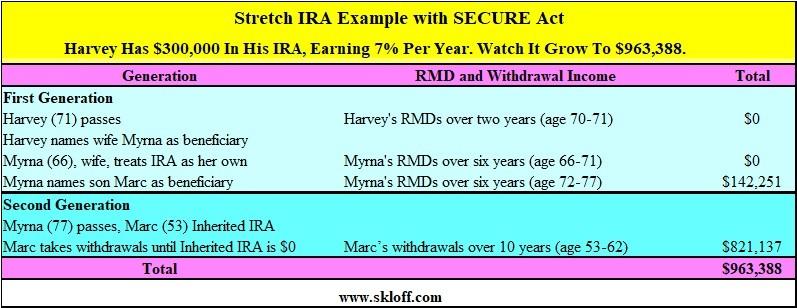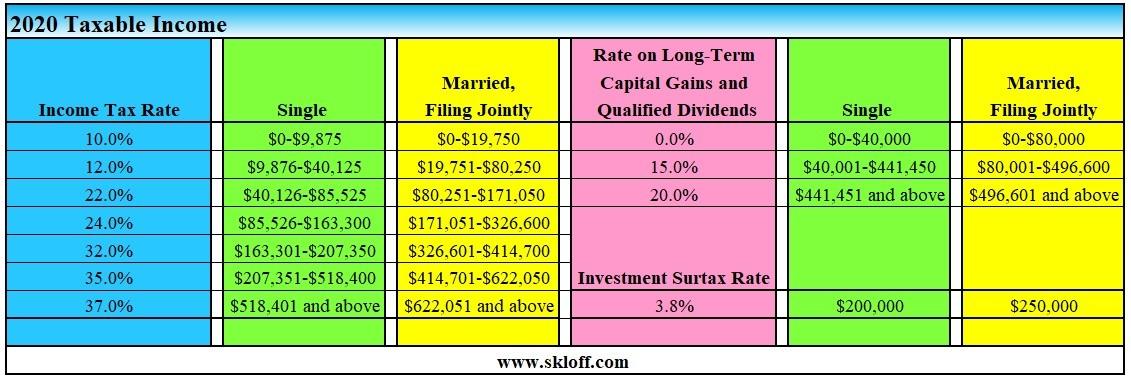The SECURE Act Brings the Biggest Changes to IRAs Since Their Inception – Part 2

Money Matters – Skloff Financial Group Question of the Month – February 1, 2020
By Aaron Skloff, AIF, CFA, MBA
Q: We read the articles: ‘Stretch IRA: Avoid Withdrawals and Taxes as Long as Possible’, ‘Roth IRA Conversions’ and ‘The SECURE Act Brings the Biggest Changes to IRAs Since Their Inception – Part 1’. We have large retirement accounts, so we are concerned about paying unnecessary taxes. How can we optimize our taxes and our beneficiaries’ taxes?
A: The Problem — Optimizing Taxes after the SECURE Act
If you stretch withdrawals too long on large retirement accounts, you could increase your own tax brackets and your beneficiaries’ tax brackets. Based on the 2020 Taxable Income table below, the higher your income (including withdrawals and Roth IRA conversions), the higher your: income tax bracket, capital gains rates and qualified dividends rates and probability you will be subject to the investment surtax. IRAs inherited after 12/31/19 must be withdrawn within a mere 10 years (spouses have an exception), potentially increasing beneficiaries’ tax brackets.
Let’s look at an example of a $300,000 IRA that grows and stretches into $963,388 over two generations, based on a 7% annual rate of return. Harvey (age 70) names his wife Myrna as his sole beneficiary, is not subject to required minimum distributions (RMDs) before passing away at age 71. Myrna (66) exercises her Inherited IRA exception by treating Harvey’s IRA as her own, names her son Marc as her sole beneficiary, is not subject to RMDS until age 72, and over six years takes RMDs of $142,251 until passing away at age 77. Marc (53, single) inherits the account as an Inherited IRA and over 10 years takes withdrawals of $821,137. Over two generations, RMDs total $963,388. See table below.
Click to Enlarge
When Harvey and Myrna filed their taxes jointly, their income tax bracket was 12%, and capital gains and dividends rates were 0%. After Harvey passed away Myrna filed her taxes as a single, which increased her income tax bracket to 22%, and capital gains and dividends rates to 15%. When Myrna started taking RMDs her tax bracket increased to 24%, double her income tax bracket when married. Based on Marc’s income, withdrawals from his Inherited IRA increased his tax bracket from 24% to 32% in some years and 35% in some years, almost 50% more than before taking withdrawals. Although Harvey, Myrna and Marc live in a state that does not assess taxes on income, capital gains, dividends, estates or inheritances, most state laws differ. Poor planning resulted in extra unnecessary taxes. See table below.
Click to Enlarge
The Solution — Accelerate Withdrawals and Roth IRA Conversions So You and Your Beneficiaries (Combined) Pay Less Taxes
If Harvey and Myrna accelerate withdrawals and convert their Traditional IRAs to Roth IRAs as joint tax filers, they can maintain a low income tax bracket of 12% or 22%, a capital gains and qualified dividends rate of 0% or 15% and avoid the 3.8% investment surtax. Joint filers can earn twice the taxable income, with twice the standard deduction compared to single filers, before they are increased to the next income tax bracket. By taking substantially equal periodic withdrawals and completing Roth IRA conversions before and in excess of RMDs, they can maximize their high joint income brackets and avoid larger RMD requirements at higher tax brackets in the future. The lower the future RMDs, the lower the probability of increased tax brackets for a surviving spouse and non-spouse beneficiaries.
Once widowed, Myrna can take substantially equal periodic withdrawals before and in excess of RMDs and convert her IRAs to Roth IRAs to avoid larger RMD requirements at higher tax brackets in the future. Since Harvey and Myrna optimized withdrawals and completed Roth IRA conversions based on their joint filer tax brackets Myrna can take more withdrawals at a 22% income tax bracket, take less withdrawals at a 24% income tax bracket and avoid the 3.8% investment surtax. Once she passes, Marc must withdrawal his Inherited IRAs by the 10th year. Since Myrna optimized withdrawals based on her tax brackets, Marc can take withdrawals and convert to Roth IRAs, with more withdrawals at a 24% income tax bracket, less withdrawals at a 32% income tax bracket and avoid the 3.8% surtax on capitals gains and qualified dividends. Good planning results in greater wealth creation, greater wealth preservation and less taxes.
Action Step — Work Closely with a Registered Investment Adviser (RIA) to Review Your Finances
Work closely with an RIA to review your estate, financial and tax plan to determine if you have the best strategies in place to build and protect your wealth. Implement the solutions described above based on your unique circumstances.
Aaron Skloff, Accredited Investment Fiduciary (AIF), Chartered Financial Analyst (CFA), Master of Business Administration (MBA) is CEO of Skloff Financial Group, a Registered Investment Advisory firm. He can be contacted at www.skloff.com or 908-464-3060.














